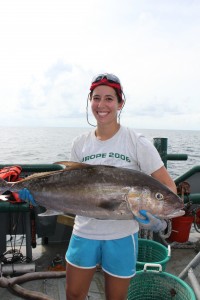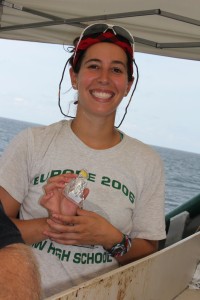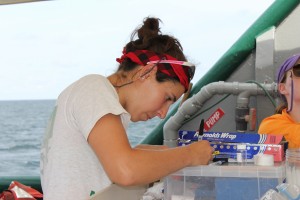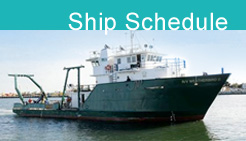Deep Sea Fish and Sediment Surveys in the Gulf
Meet C-IMAGE Graduate Students
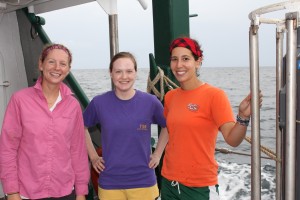
During our current expedition three new USF graduate students are participating, Liz Herdter, Jacquelin Hipes and Susan Snyder. Enjoy meeting these C-IMAGE graduate students who are working with C-IMAGE Chief Scientist, Steve Murawski. It is truly an exceptional opportunity to begin the first week of graduate school sailing aboard the Weatherbird II as part of the August cruises. For two students, this is their first time on a research cruise. This C-IMAGE cruise is These ladies, aka ‘the fish ladies’ have been immersed during the longline bottom fishing. These students have tirelessly processing the demersal fishes– snapper, tilefish, grouper, eels and sharks collected at depths of 100 to over 1000 meters. The processing includes making standard and fork length measurements, weighing the fish, and removing blood and tissue samples.
Susan Snyder: Master’s Student, USF College of Marine Science (Advisor- Steve Murawski)
I got my BS in Biology and a minor in Chemistry from the State University of New York at Geneseo. During my undergraduate research I studied symbiotic cyanobacteria living within clonal sea star larvae collected from the gulf stream and also the macrophyte communities in Conesus Lake. I am now starting my Master’s degree with a concentration in Marine Resource Assessment at USF College of Marine Science working with Dr. Steve Murawski. This cruise on the Weatherbird has been my first experience as a new student at USF. It’s been a lot of hard work and long days but I am having so much fun! It’s great to be out in the ocean with a team of scientists so dedicated and enthusiastic about their work! I am very much looking forward to starting classes and my new life in St Pete!
Liz Herdter: Master’s Student, USF College of Marine Science (Advisor- Steve Murawski)
I got my BS in Biology at Boston University. During the past seven months I have been working in Dr. Steve Murawski’s lab as a research technician. I have been on several longline cruises this summer. However, this August C-IMAGE cruise is my first time aboard the Weatherbird II. This Fall I am starting my Master’s degree with a concentration in Marine Resource Assessment at USF College of Marine Science and will continue my work with Dr. Murawski. This cruise aboard the Weatherbird II has been fun and very rewarding.
Jacquelin Hipes: Master’s Student, USF College of Marine Science (Advisor- Steve Murawski)
I’m just starting the first year of my MS in Biological Oceanography at USF CMS. I graduated from Louisiana State University in May 2012 with a BS in Biological Sciences and a concentration in marine biology (Geaux Tigers!). I was born and raised in Dallas, TX, but that didn’t stop me from being fascinated with marine science from a very young age. (I’d also like to take up a little space to say “Howdy” to my parents, Jackie and Mark, and brothers, Chris and Austin, back home- love y’all!)
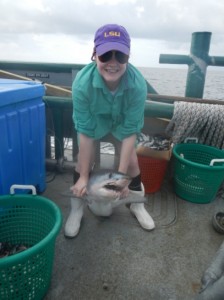
Jacquelin Hipes (USF-marine science graduate student) with shark sampled as part of C-IMAGE August cruise
The reason I’m so excited to be working with Steve at USF is that I can finally branch away from the invertebrate work I did in my undergraduate years and study sharks! I’m on the first leg of the Weatherbird II cruise right now to help Steve longline for benthic fishes and collect samples of organs, tissue, and otoliths (ear bones) for analysis at the College’s lab in St. Petersburg. Our lab group is particularly interested in if any of these animals have been negatively impacted by the 2010 Deepwater Horizon oil spill. Since I’ve just started, I don’t have my own project yet but I definitely have some good ideas to consider, now that I’ve spent almost a week on a research vessel!
| Print article | This entry was posted by greely on August 19, 2012 at 11:09 pm, and is filed under Oceanic Updates. Follow any responses to this post through RSS 2.0. You can leave a response or trackback from your own site. |

